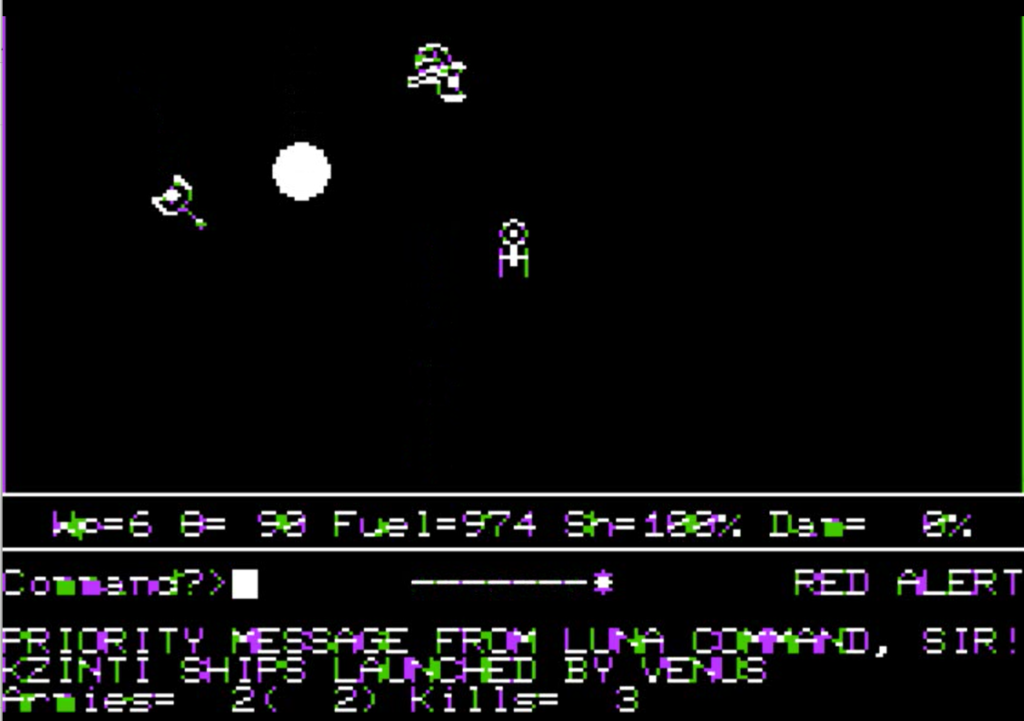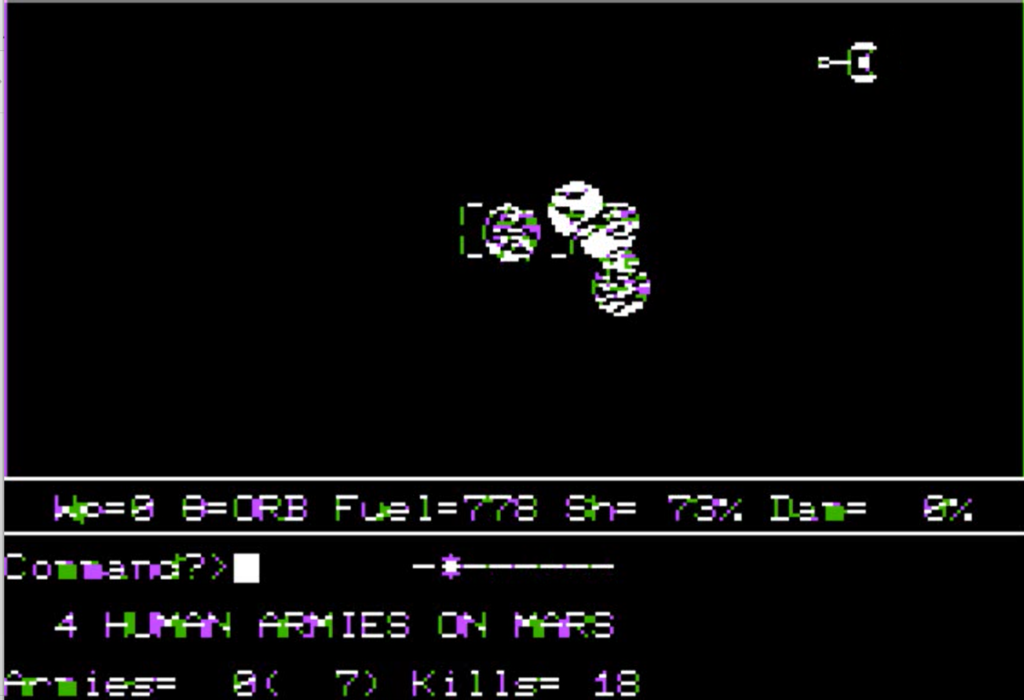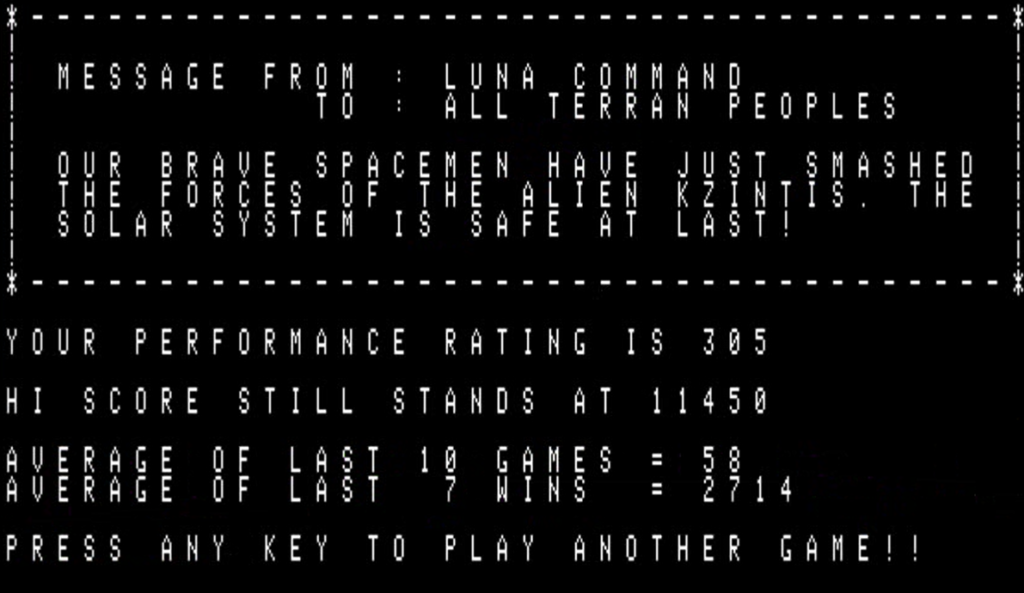[Siro-Tech, Apple II]

Well, the Kzintis are at it again. Of course, you’ve heard of the Kzintis, those weirdly popular cat-like aliens from two episodes of the forgotten Star Trek : the Animated Series who managed to creep in a good chunk of Star Trek unofficial content (as well as “definitely-not-Star-Trek-I-swear” content), and ultimately probably inspired Wing Commander’s Kilrathis.
You know, the Kzintis.
So, the Kzintis invaded most of the solar system, except Earth and the Moon. Guess who is tasked with chasing them off every planet. Well, off every planet from Mercury to Mars because for the purpose of this AAR I chose a “short” game rather than the whole thing with 11 planets and satellites.

I had just finished reading my briefing when a bunch of Kzinti warships approached Earth. I accelerated to break orbit, and moved toward them to engage. They flew together, and packed quite a punch. The combined strength of the missiles and phasers was too much for me to handle. I accelerated to warp factor 9, and evaded combat :

In Galactic Attack, the main resource is “Fuel”, which is consumed by moving (how quickly depends on the warp factor, in another word speed), by charging the shield or by attacking with either long-range-but-weak torpedoes or short-range-but-powerful phasers.
Happily enough, fuel regenerates automatically on its own even in deep space, and trotting at moderate speed in a long tour that brought me as far as Mars, I returned, fuel and shield mostly regenerated, to fight a second round :

With one Kzinti ship destroyed, I could easily overcome the two others, and returned to Earth for a faster refuelling.
My starship can carry armies. Initially only one at a time, but every 3 Kzinti ships destroyed, I somehow find the room to carry one more army (I suppose OSHA gets less and less picky as they realize the real threat is the Kzintis, not the cramped transport conditions on my ship). For reasons I will explain soon, anything below 3 armies is not really worthwhile hauling around, so I decide to wait for a new wave of Kzinti ships while transferring troops from Earth to the Moon. This is not totally useless : the Moon starts with only one army, and once you have 3 or more armies on a planet or satellite, these armies start to love one another very much and generate more little armies to deploy.

After some time, I was informed that a new Kzinti wave of three ships had been launched, and I moved to engage them :

I destroyed them eventually, which you’ve probably guessed, because sessions where I die early don’t make good AARs.
I am now able to carry three armies, which is what I need to liberate the Solar System from the evil paw of the Kzinti oppressors.
To liberate a planet, I need to beam down as many armies as the Kzintis have locally. The problem is that the Kzintis have a lot more than 3 armies on their planets. The solution is as usual more phasers in their hairy faces – I can “strafe” planets down to 3 Kzinti armies (never fewer), after which my armies can take over the planet.
There is one caveat : to beam up, beam down or strafe anything, I need to lower my shield. This is pretty safe when I am orbiting Earth or the Moon, less so when I am orbiting a hostile planet, as the ruthless kitties shoot back. This means I must orbit the planet, power down my shield, strafe the planet 4 times (5 times if I am feeling lucky), accelerate out of orbit, either wait for my ship to repair itself, or activate accelerated reparation (the latter stops my ship and keeps my shield powered down), then come back for a second round of plasma death from spaaaace.

The one real difficulty is that from time to time, new Kzinti spaceships spawn, and if they happen to spawn from the planet I am attacking at that very moment, I am toast.
In my case, it did not happen, and after reducing Mercury to 3 armies I beamed down my guys, who all died killing the Kzintis at a perfect 1:1 ratio. One more journey to Earth and back, and Mercury is now speaking human again, the way God intended. Another wave of Kzinti spaceships was defeated soon after that.
At this point I could transport 5 armies, but I only need 4 of them : each army costs 1 in fuel every tick, so I do not want to take too many of them. I suppose having exactly 6 can be useful in a longer game to make sure any conquered planet immediately starts churning its own armies – but having 5 is definitely useless.
Using the same method, I soon conquer Venus – it was teeming with Kzintis so it took me significant time, especially since I had to interrupt my assaults frequently to wait for the next Kzinti wave, lest it spawned on me. Once Venus fell, the next (and last) wave of Kzintis reinforcements appeared on the edge of the solar system, giving me ample time to also conquer Mars.

After one final battle against the 3 Kzinti ships, I won the game :

This is a short account of Galactic Attack, the first game by Siro-Tech, which would soon be famous for their Wizardry games. The DataDrivenGamer has written an account of a full campaign liberating all 11 planets and satellites of the solar system. The Digital Antiquarian has an article on the history of Galactic Attack and early Siro-Tech – as usual highly recommended.
The reason I played Galactic Attack is that I wanted to check whether it was a strategy game, because if it is one then it is a contender to be one of the first if not the first RTS. Alas, in spite of Siro-Tech claiming “Strategy and Tactics combined” in the waiting screen of the game, there is no strategy in Galactic Attack. The Kzintis don’t attack your planets, nor do your planets act on their own. The worst that can happen to you while you are far from a planet is a revolt making that planet switch back to the Kzinti side, and even that it only happens when the planet is not garrisoned properly. Conquering the planets involves as much strategy as going efficiently through a grocery list ; it is only a pretext to make you fight the Kzinti spaceships and put you in dangerous situations (shield down, maybe damaged from a strafing run, or low-fuel because you carry too many armies).
I guess I cannot deny it has real-time tactical combat, if you’re willing to consider one tick every 2 seconds as “real-time”. Even then, the tactical part of Galactic Attack feels like a simplified Trek73 (energy/fuel management, choice between missiles and phasers, angle of movement and fire you need to input manually,…) and Starbase Zero was already a “slow real-time” Trek73. Cytron Masters remains, in my opinion, the first real-time strategy PC game in history.